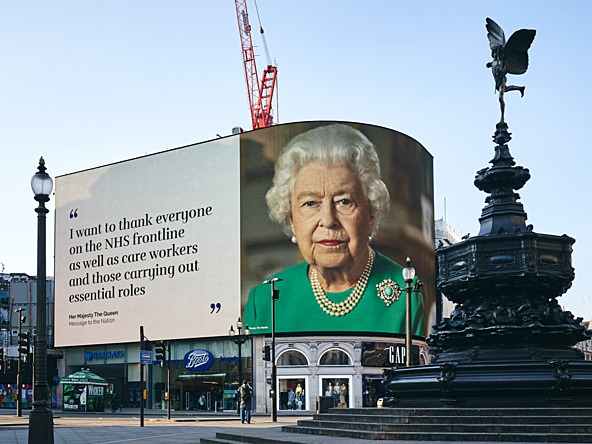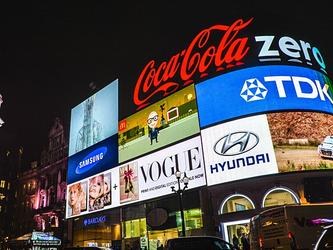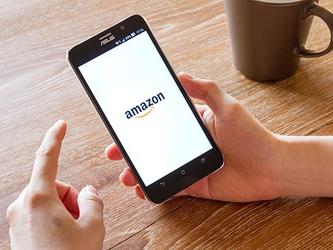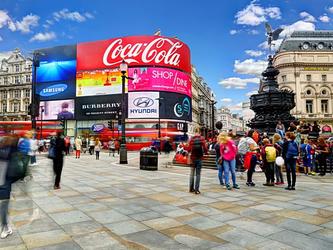Pandemic recovery boosts UK ad spend to record level

The latest Advertising Association (AA)/World Advertising Research Centre (WARC) full-year figures reveal the 2021 ad market emerged £8bn ahead of April 2020’s original forecast of £24bn set at the beginning of the Covid-19 pandemic. This growth is in part due to inflationary pressures on the cost of advertising, but also a higher-than-expected growth in key forms of online advertising during the past year.
Three in every four pounds spent on UK advertising today is invested in one of a wide range of online formats – only China has an equivalent online share of this proportion. New data shows internet ad spend totalled £23.5bn in 2021, equivalent to 73.5% of all UK ad spend and a jump up of 11.7 percentage points from pre-pandemic levels in 2019.
Notable shifts were seen in ad spend during the pandemic, with the UK government quickly becoming the country’s largest advertiser to drive mass behaviour change. This shift is further examined in the report, entitled, UK Advertising’s Ad Spend Review: The Pandemic Effect. The review also notes the pandemic has seen a disruption in the usual relationship between GDP and ad spend.
Forecasting the years ahead
The latest AA/WARC data presents an upgrade to the previous forecasts for 2022. The UK’s ad market is forecast to grow by 10.7% this year to £35.3bn, driven by a strong start to the year, higher CPMs (cost per 1,000 impressions) and higher demand ahead of the FIFA World Cup. In 2023, this is set to add an additional 5.4% year-on-year to reach £37.2bn, though economic headwinds – particularly in relation to cost of living pressures and supply chain disruption – mean this is liable to review.
Online threshold marks a new era of advertising
The figures show search, inclusive of e-commerce, proved to be the strongest performer in 2021 – at £11.7bn it beats April 2020’s projection (made during the onset of Covid-19 ) by over £3.7bn. In addition, TV surpassed early expectations by almost £1bn, while online video overperformed by approximately £2bn and social media by £2.3bn in relation to the forecasts made at the start of the pandemic.
The review also contains commentary from Credos, highlighting the close link between internet retail spend and online ad spend. With online retail spend of $2,648 per capita, the UK has the world’s most avid online shoppers. In tandem, the UK ad industry is seeing an exponential demand for digital skills and talent to serve this demand.
Commentary from WARC concludes that the changes seen in the advertising market during the pandemic allude to an emerging structural shift, one which points to a new era of advertising, with retail media poised to play a more prominent role in future.
Commenting on the report’s findings, Advertising Association chief executive Stephen Woodford said: “The UK has held its position in 2021 as the largest advertising market in Europe through the pandemic and is now the third largest in the world, behind the US and China. While further growth is forecast, inflationary pressures on the cost of advertising, and more generally, due to the ongoing geo-political uncertainties, mean we should be cautious.
“Innovation, creativity and responsiveness will be critical in the years going forward, as we build a sustainable future for our industry, and help businesses, large and small, build relationships with their customers.”
Industry feedback
Research Live worked with PR agency Pumpkin to canvass reaction to the UK Advertising’s Ad Spend Review: The Pandemic Effect report, here’s what a cross-section of industry leaders had to say on the subject:
Allan Blair, head of strategy, VaynerMedia
The increase in ad spend shouldn’t come as a surprise to anyone. As we emerge from the pandemic, people are rediscovering lost freedoms, indulging new passions discovered during lockdown and slipping back into old habits. Consumer spending is on the rise. However, the cost-of-living crisis is taking hold, so people are becoming more discerning about how, where and when to part with their hard-earned cash. Brands are having to fight harder to win a more cost sensitive audience.
In this environment, of course brands are turning to digital media. Not only do they see it as a quicker, more cost-effective and direct way to reach consumers, but they increasingly see it driving deeper and more powerful brand engagement and influence. Again, this shouldn’t be a surprise. We have spent the past two years stuck at home with little more to do than waste hours on Instagram, surf Netflix trying to decide what to watch, or browse ASOS planning the perfect party outfit for when we are finally free. Digital was a mainstream behaviour before the pandemic, it’s now as vital as oxygen.
Many commentators will claim this is a post-lockdown blip, that things will level off to pre-pandemic levels. They will pull out well-worn charts declaring the power of traditional media is stronger than ever. Yet every day we speak to clients keen to shift ad money online, who want to build their brands from social and who see digital as not just a channel for efficient media, but one to build equity, engagement and consumer influence in an organic and natural way as they have never been able to before.
Gill Huber, managing partner, Oystercatchers
While we are seeing positive advertising growth and pandemic-related risks receding, there are ongoing tough market drivers that mean consumers will continue to err on the side of caution with their spending. However, the UK ad industry is well placed to cope with tough market factors – with adversity being a great driver of creative opportunities. If brands can grasp these opportunities well, it can help them prosper despite future pressures.
Brands will have the tough job of continuing to adapt to changing behaviour and will need to approach a variety of consumers – from those who want to spend post-lockdown, to others who are tightening their belts because of cost-of-living constraints – with sensitive communications. Brands that develop their ‘north star’ to optimise their strategies will flourish, because despite the continued uncertainty, strong optimism and increasing opportunities for the year ahead means brands need to prepare for continued growth.
As we move out of the short-term reactivity created by the pandemic, strong client-agency partnerships will be essential to help navigate changing consumer needs, as well as identifying the best way to reallocate budgets to build brands and ensure those brands are showing up on the right media.
Alex Charkham, chief strategy officer, Fuse
While there are clearly concerning macro factors and a general air of uncertainty that cannot be ignored, the latest AA/WARC figures show a very robust UK advertising market that has faced the challenge of the pandemic and coped. Even taking inflation into account, £31.9bn – making the UK the third largest ad market in the world – is significant. And with the FIFA World Cup kicking off in Qatar in November this year, there will be a much bigger advertising spend boost at the tail end of the year than we’d normally get from Christmas alone.
Despite the unusual timing and concerns from some corners about the location, the tournament is a global sporting phenomenon and we can expect to see a corresponding surge in advertising support across all media as brands look to capitalise on worldwide audiences focused intently on the football.
We anticipate the sport and entertainment sponsorship market to have grown in a similar way to advertising, with sponsorship becoming an increasingly appealing solution to mitigate the increasing cost of advertising and help brands find a point of difference within a cluttered media landscape
The anticipated uplift delivered by the FIFA World Cup once again shows that sport is one of the few, mass ‘appointments to view’ left on free to air TV. With media fragmentation and growth of ad-less streaming services causing an ongoing headache for advertisers, sport provides an incredibly powerful platform for brands that can be activated in a number of ways, from advertising to sponsorship, media partnerships and talent deals.
Tom Roberts, chief executive, Tribal Worldwide
Pandemic economic recovery has certainly bounced back extraordinarily well when looking at these figures. With online advertising leading the way at an incredible £11.7bn in ad spend, it is clear to see that brands are tapping into the UK’s significant $2,648 per capita online retail spend.
With this continual increase in demand for ecommerce, it will be important for brands to not only provide their customers with a seamless, blended retail experience as they shop across multi-channels, but they will also need to work on retaining a workforce that meets the increased demand for digital skills and expertise. Supporting employees as we continue to experience economic uncertainty along with the current volatile geo-political situation, will be essential to help brands continue to innovate and build good relationships with their customers.
Melanie Welsh, founding partner, Strat House
We’ve long known the glory days of television-focused advertising, when brands had the luxury of time and attention to land multiple messages, are gone. In this many channelled world, advertisers may only have three seconds to best convey their brand essence – so we’ve moved to simpler, more defined work to tell brand stories on digital platforms.
But move we have – as these figures show with almost 75% of UK ad spend now online. And when media and creative teams work closely together, interesting media buys can lead to great creative ideas that do not have TV as the centre of their universe. What has always mattered most – and will continue to matter most, regardless of relative share of media spend – is strong brand identity and strong brand positioning. With this a business can weather inflation, conflict, supply chain constraints and much more.
David Kells, director of strategic partnerships, Raconteur
The latest WARC UK ad spend review is exciting – with growth in spend comes increased innovation and creativity, creating new opportunities for brands to reach their audiences.
This is demonstrated by the notable increase in spend across multiple digital formats in the UK. While the outlook for the year is very strong, media owners will remain cautious given the rate of disruption during the past three years. As noted in the report, the UK’s ad market is forecast to grow by 10.7% this year to £35.3bn after a strong start, however economic and political instability will undoubtedly have an impact on the forecast as the year continues.
The numbers remain strong however, and no matter what the ramifications of wider global issues, the demand for effective advertising will continue to boom.’
Lori Meakin, founder, Joint
It’s great news for the industry that UK ad spend has experienced such extraordinary growth, up 34.3% year-on-year. And that should be a good sign for the economy – although a disruption in the link between ad spend and GDP and a looming cost of living crisis may well give us pause.
With nearly three quarters of all UK ad spend now online in some form, including broadcaster video on demand (BVOD), it will be interesting to watch the continuing digital/real life interplay, as people continue to research and shop online as well as off, engage in social media and entertainment in ways new and old, and demand both information about and an escape from the harsh realities of life. Because however much our industry still loves to differentiate between online and offline, above and below the line, real humans are decidedly omnichannel creatures.
And of course, it’s the people this ad spend is targeting that really matters, not just the amount of spend. Who are we targeting with these billions of pounds of spend, and what do they really care about, that brands and advertisers can help them with? Despite having more data on audiences, users and consumers than ever, our industry still has too little real understanding of the diverse lived experiences and priorities of those people.
For instance, 80% of purchase decisions are driven by women and yet ad land can still be heard trading in ‘housewives with kids’ as if we’re the 1950s, as well as filling space with work that’s simply ‘brand-splaining’ and doesn’t leave valuable under-represented audiences feeling seen.
No matter how much any of us in our industry pays to get in front of people, it’s only when we truly respect them and contribute something of real value to them that we do our audiences and ourselves justice. And that, ultimately, is the big win.
Verity Brown, managing director, The Specialist Works
The brilliant economist, JK Galbraith, said, “The only function of economic forecasting is to make astrology look respectable”. Forecasting future trends is tough. Last week the chief executive of EON said that up to 40% of homes may experience fuel poverty in Q4 and predicting the effect of the Ukraine war on already stressed supply chains is difficult.
Smart data-driven planning, accountability and flexibility will continue to drive investment. More brands are direct to consumer and judicious investment will generate demand.
We expected to see predicted growth in shorter-term, performance-focused digital channels. Equally we agree with increases in more accountable, data-driven channels like BVOD, we’re excited about the launch of ITVX.
Direct Mail is forecast to decline in 2022 and 2023, possibly due to print costs, however these can be mitigated by smart planning. The coalescence of home working and flight from cities will not be reversed and underlines the importance of targeting. Retail clients are exploring omnichannel solutions, direct to home media is important in driving both footfall and e-commerce.
Q4 could be tough, a perfect storm of an atypical World Cup, energy price cap increasing again in October and supply chain issues affecting pre-Christmas production. We expect clients will want to spend but will focus on channels that they can commit to later and where there is a greater chance of immediate return. We also expect to see a greater focus on targeting older audiences, who may have greater disposable incomes.
WARC alludes to significant growth of retail media, McKinsey forecast $100bn spend with retail media networks by 2024, because of improved accountability and performance. We expect brands to focus spend into channels that drive immediate uplift, whether in--store or at home.
In a challenging couple of years, smart data-driven planning, accountability, and flexibility will continue to drive investment.
Vicky Bullen, chief executive, Coley Porter Bell
It’s not often that a set of figures showing such positive growth in the UK marketing and advertising world would be greeted with caution, but in these perilous times that’s a necessary response. A record £31.9bn in ad spend is significant – but so too is 7% inflation, not seen since 1992; growth of more than 34% is impressive, but this needs to be viewed against the backdrop of the Covid-19 slump.
However, what the figures do reveal is how entrenched the changes in our branding and advertising landscape are. Online advertising dominates, securing almost three quarters of the market. Covid escalated every brand’s need for ecommerce – online retail spend among Brits is the highest per capita in the world – and search, correspondingly, was 2021’s top performer.
Structural changes in advertising media are mirroring behavioural changes in shoppers and brands are responding with immersive brand building that extends across media and the multiple touchpoints of the purchasing journey.

We hope you enjoyed this article.
Research Live is published by MRS.
The Market Research Society (MRS) exists to promote and protect the research sector, showcasing how research delivers impact for businesses and government.
Members of MRS enjoy many benefits including tailoured policy guidance, discounts on training and conferences, and access to member-only content.
For example, there's an archive of winning case studies from over a decade of MRS Awards.
Find out more about the benefits of joining MRS here.














0 Comments